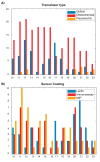Recent Advances in Development of Biosensors for Monitoring of Airborne Microorganisms
- PMID: 39220332
- PMCID: PMC11364924
- DOI: 10.30498/ijb.2024.399314.3722
Recent Advances in Development of Biosensors for Monitoring of Airborne Microorganisms
Abstract
Background: The early detection of infectious microorganisms is crucial for preventing and controlling the transmission of diseases. This article provides a comprehensive review of biosensors based on various diagnostic methods for measuring airborne pathogens.
Objective: This article aims to explore recent advancements in the field of biosensors tailored for the detection and monitoring of airborne microorganisms, offering insights into emerging technologies and their potential applications in environmental surveillance and public health management.
Materials and methods: The study summarizes the research conducted on novel methods of detecting airborne microorganisms using different biological sensors, as well as the application of signal amplification technologies such as polymerase chain reaction (PCR), immunoassay reactions, molecular imprinted polymers (MIP) technique, lectin and cascade reactions, and nanomaterials.
Results: Antibody and PCR detection methods are effective for specific microbial strains, but they have limitations including limited stability, high cost, and the need for skilled operators with basic knowledge of the target structure. Biosensors based on MIP and lectin offer a low-cost, stable, sensitive, and selective alternative to antibodies and PCR. However, challenges remain, such as the detection of small gas molecules by MIP and the lower sensitivity of lectins compared to antibodies. Additionally, achieving high sensitivity in complex environments poses difficulties for both methods.
Conclusion: The development of sensitive, reliable, accessible, portable, and inexpensive biosensors holds great potential for clinical and environmental applications, including disease diagnosis, treatment monitoring, and point-of-care testing, offering a promising future in this field. This review presents an overview of biosensor detection principles, covering component identification, energy conversion principles, and signal amplification. Additionally, it summarizes the research and applications of biosensors in the detection of airborne microorganisms. The latest advancements and future trends in biosensor detection of airborne microorganisms are also analyzed.
Keywords: Airborne Pathogens; Antibody; Biosensor; Lectin; Nanoparticles; Point of Care (POC).
Copyright: © 2021 The Author(s); Published by Iranian Journal of Biotechnology.
Conflict of interest statement
The authors declare that they have no conflict of interest.
Figures






Similar articles
-
Advances in airborne microorganisms detection using biosensors: A critical review.Front Environ Sci Eng. 2021;15(3):47. doi: 10.1007/s11783-021-1420-8. Epub 2021 Apr 5. Front Environ Sci Eng. 2021. PMID: 33842019 Free PMC article. Review.
-
Gold nanoparticles-based biosensors: pioneering solutions for bacterial and viral pathogen detection-a comprehensive review.World J Microbiol Biotechnol. 2024 Jul 16;40(9):269. doi: 10.1007/s11274-024-04072-1. World J Microbiol Biotechnol. 2024. PMID: 39009934 Review.
-
The Potential of Optical Technologies in Early Virus Detection; Prospects in Addressing Future Viral Outbreaks.Crit Rev Anal Chem. 2025 Mar 27:1-29. doi: 10.1080/10408347.2025.2481406. Online ahead of print. Crit Rev Anal Chem. 2025. PMID: 40146886 Review.
-
Recent advances in the analytical strategies of microbial biosensor for detection of pollutants.Chemosphere. 2022 Nov;306:135515. doi: 10.1016/j.chemosphere.2022.135515. Epub 2022 Jun 27. Chemosphere. 2022. PMID: 35772520 Review.
-
Air cleaning technologies: an evidence-based analysis.Ont Health Technol Assess Ser. 2005;5(17):1-52. Epub 2005 Nov 1. Ont Health Technol Assess Ser. 2005. PMID: 23074468 Free PMC article.
References
-
- Després VR, Alex Huffman J, Burrows SM, Hoose C, Safatov AS, Buryak G, et al. Primary biological aerosol particles in the atmosphere: A review. Tellus B. 2012;64(1) doi: 10.3402/tellusb.v64i0.15598. - DOI
-
- Miripour ZS, Sarrami-Forooshani R, Sanati H, Makarem J, Taheri MS, Shojaeian F, et al. Real-time diagnosis of reactive oxygen species (ROS) in fresh sputum by electrochemical tracing; correlation between COVID-19 and viral-induced ROS in lung/respiratory epithelium during this pandemic. Biosens Bioelectron. 2020;165(June):112435. doi: 10.1016/j.bios.2020.112435. - DOI - PMC - PubMed
Publication types
LinkOut - more resources
Full Text Sources
